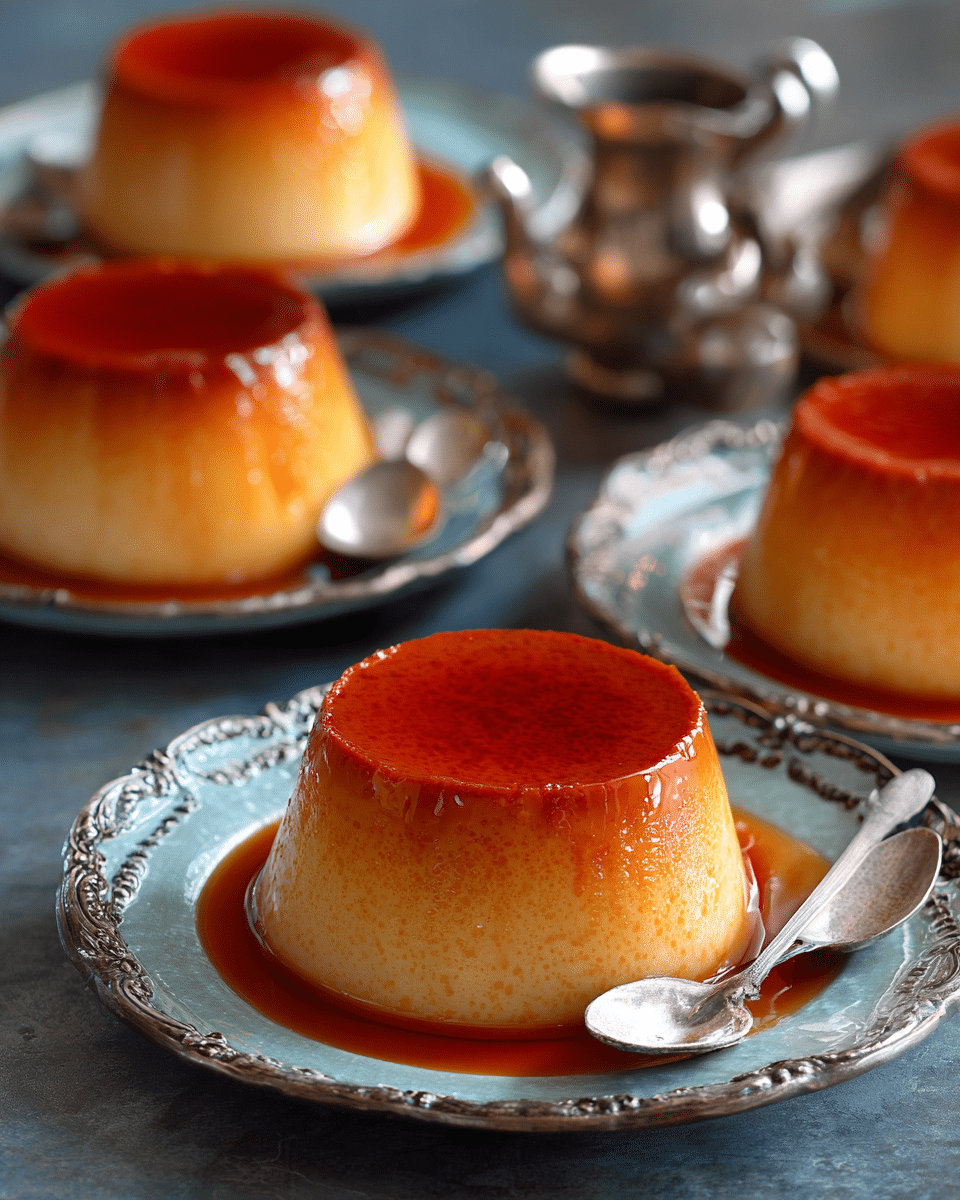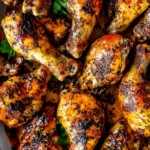Dulce de Leche Flan is a rich and creamy Latin dessert that combines the luscious depth of caramelized milk with the smooth texture of traditional flan. This indulgent treat is especially beloved throughout Latin America and Spain, where flan is a staple on special occasions. What sets this version apart is the incorporation of dulce de leche, which lends a deeper, toffee-like sweetness and a slightly firmer texture.
FULL RECIPE
Ingredients
- 1 cup granulated sugar (for caramel)
- 1 can (13.4 oz) dulce de leche
- 1 can (14 oz) sweetened condensed milk
- 1 can (12 oz) evaporated milk
- 3 large eggs
- 2 large egg yolks
- 1 teaspoon vanilla extract
- Pinch of salt
Directions
- Preheat your oven to 350°F (175°C). Place a large roasting pan in the oven and fill it halfway with hot water to prepare a water bath.
- In a medium saucepan over medium heat, melt the granulated sugar, stirring occasionally, until it turns into a golden caramel. Quickly pour the caramel into a 9-inch round cake pan or flan mold, tilting to coat the bottom evenly. Set aside to cool and harden.
- In a large bowl, whisk together dulce de leche, sweetened condensed milk, evaporated milk, eggs, egg yolks, vanilla extract, and salt until smooth and fully combined.
- Pour the custard mixture into the caramel-coated pan.
- Carefully place the flan pan in the center of the water bath inside the preheated oven.
- Bake for 50–60 minutes or until the flan is set but still slightly jiggly in the center. A knife inserted should come out mostly clean.
- Remove the flan from the water bath and let it cool to room temperature. Then refrigerate for at least 4 hours or overnight.
- To serve, run a knife around the edges of the flan to loosen it. Place a serving plate on top and invert quickly to release the flan and reveal the caramel topping.
Nutrition Facts
- Calories: 360
- Total Fat: 14g
- Saturated Fat: 7g
- Cholesterol: 135mg
- Sodium: 160mg
- Total Carbohydrates: 51g
- Dietary Fiber: 0g
- Sugars: 50g
- Protein: 8g
Origins and Cultural Significance
Dulce de leche flan is a beloved dessert that combines the culinary traditions of flan from Spain with the Latin American passion for dulce de leche, a sweet caramelized milk spread. This fusion dessert has become a staple across countries like Mexico, Argentina, and Colombia, where flan already holds a prominent place in festive meals. The addition of dulce de leche brings a uniquely Latin American twist to the classic custard, deepening its flavor and aligning it with other caramel-rich desserts popular in the region. The dessert reflects the creative adaptation of global influences into localized versions, resulting in something both traditional and innovatively regional.
Texture and Flavor Profile
Dulce de leche flan boasts a rich, silky texture that sets it apart from other custards. Its velvety consistency is a result of the slow baking process in a water bath, which allows the eggs and milk to coagulate gently without curdling. The incorporation of dulce de leche enriches the custard with a dense creaminess and a complex, toffee-like sweetness. Paired with the signature layer of caramel on top, the dessert delivers an indulgent depth of flavor that balances sweetness with the slight bitterness of caramelized sugar, creating a truly satisfying mouthfeel and taste experience.
Nutritional Considerations
While dulce de leche flan is undeniably decadent, it also provides modest amounts of protein and calcium from the eggs and dairy used in the custard. However, it is high in sugars and saturated fats due to the dulce de leche and condensed milk, making it more of an occasional treat than an everyday indulgence. A single serving can range between 300 to 400 calories, with significant sugar content, so portion control is important for those monitoring their dietary intake. Lighter variations can be made, but the original version is best enjoyed in moderation as part of a balanced lifestyle.
Popular Variations
There are many creative spins on the traditional dulce de leche flan recipe. Some versions include a layer of crushed nuts such as pecans or almonds on the caramel for added crunch. Others infuse the custard with coffee, rum, or citrus zest to introduce additional complexity. For a tropical twist, coconut milk can be used in place of evaporated milk, creating a Caribbean-style flan. In some Argentine households, the flan is topped with whipped cream or an extra drizzle of dulce de leche, enhancing its already rich profile. These variations reflect the versatility of the base recipe while honoring regional preferences.
Serving Suggestions
Dulce de leche flan is best served chilled, allowing the custard to fully set and the caramel to soften and drizzle over the top. It’s typically inverted onto a plate for a striking presentation, revealing the glossy caramel coating. The flan can be garnished with fresh berries, mint leaves, or a dusting of cinnamon for color contrast and added flavor. Some enjoy serving it with a dollop of whipped cream or alongside a scoop of vanilla ice cream to complement the rich caramel tones. It’s an ideal finish to a hearty meal or a standout offering at a celebration.
Beverage Pairings
This dessert pairs wonderfully with a range of beverages that can either complement or contrast its sweet, creamy character. A strong espresso or black coffee provides a bitter counterbalance to the flan’s sweetness. For something milder, a glass of cold milk or a café con leche enhances the creaminess. In terms of alcoholic pairings, a sweet sherry, port wine, or a dessert wine like Moscato accentuates the caramel notes. Some even enjoy pairing it with a light rum cocktail or a dark stout beer for a more adventurous combination.
Storage and Make-Ahead Tips
Dulce de leche flan is an excellent make-ahead dessert, as its flavor and texture improve after chilling. It should be stored covered in the refrigerator, where it can last up to five days without compromising quality. It’s important to keep the flan in its mold until ready to serve, as this preserves the integrity of the caramel topping. Freezing is not recommended because the texture of the custard may become grainy once thawed. For those hosting a gathering, preparing the flan a day in advance can help reduce last-minute stress while ensuring a perfectly set dessert.
Common Mistakes and Troubleshooting
Achieving the perfect dulce de leche flan requires careful attention during cooking. One of the most common mistakes is overcooking, which can cause the custard to become rubbery or cracked. Using a water bath is crucial to ensure gentle, even heat distribution. Another issue is improperly caramelizing the sugar, which may lead to a burnt or crystallized topping; the key is to heat the sugar slowly without stirring excessively. When unmolding the flan, letting it sit at room temperature briefly or dipping the mold in warm water can help release it cleanly and prevent breakage.
Presentation and Plating Ideas
The visual appeal of dulce de leche flan lies in its glossy caramel coating and smooth, golden surface. For elegant presentation, serve it on a white or glass plate to highlight its rich color contrast. You can decorate the plate with caramel drizzle patterns or a light cocoa dusting around the flan’s edges. For more elaborate plating, add edible flowers, piped whipped cream, or a quenelle of ice cream beside the flan. Individual ramekin servings are also a popular choice for dinner parties, offering a refined and mess-free option that doesn’t require slicing.
Adapting for Special Diets
Although traditional dulce de leche flan is rich in dairy and eggs, it can be adapted for those with dietary restrictions. For a lactose-free version, substitute plant-based evaporated and condensed milks, along with a dairy-free dulce de leche alternative. Vegan flan variations use ingredients like coconut milk, agar-agar, or silken tofu to mimic the creamy custard texture. For reduced sugar, unsweetened condensed milk and sugar-free dulce de leche can help lower the overall sweetness. Keep in mind that these modifications may slightly alter the texture and flavor, but they can still result in a satisfying, indulgent treat.
Conclusion
Dulce de leche flan is a celebration of Latin culinary tradition, blending rich ingredients with a sophisticated texture and flavor profile. Whether served at a family gathering or a festive holiday meal, this dessert continues to captivate with its luxurious caramel notes and silky custard body. With its versatility, ability to be prepared ahead, and potential for creative adaptations, dulce de leche flan stands out as a timeless classic.






